Here we are going to discuss about complex numbers:
- What is complex number..?
- Calculations of complex numbers
- Addition of complex numbers
- Subtraction of complex numbers
- Multiplication of complex numbers
- What is iota(i) ..?
- What is the value of iota..?
- Theories of complex numbers..
- And many more..
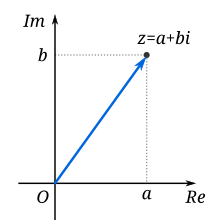
A complex number can be visually represented as a pair of numbers (a, b) forming a vector on a diagram called an Argand diagram, representing the complex plane. "Re" is the real axis, "Im" is the imaginary axis, and i satisfies i2 = −1.
A complex number is a number that can be expressed in the form a + bi, where a and bare real numbers, and i is a solution of the equation x2 = −1. Because no real numbersatisfies this equation, i is called an imaginary number. For the complex number a + bi, a is called the real part, and b is called the imaginary part. Despite the historical nomenclature "imaginary", complex numbers are regarded in the mathematical sciences as just as "real" as the real numbers, and are fundamental in many aspects of the scientific description of the natural world.[note 1][1]
Complex numbers allow solutions to certain equations that have no solutions in real numbers. For example, the equation
has no real solution, since the square of a real number cannot be negative. Complex numbers provide a solution to this problem. The idea is to extend the real numbers with an indeterminate i (sometimes called the imaginary unit) that is taken to satisfy the relation i2 = −1, so that solutions to equations like the preceding one can be found. In this case the solutions are −1 + 3i and −1 − 3i, as can be verified using the fact that i2 = −1:
According to the fundamental theorem of algebra, all polynomial equations with real or complex coefficients in a single variable have a solution in complex numbers. In contrast, some polynomial equations with real coefficients have no solution in real numbers. The 16th-century Italian mathematician Gerolamo Cardano is credited with introducing complex numbers in his attempts to find solutions to cubic equations.[2]
Formally, the complex number system can be defined as the algebraic extension of the ordinary real numbers by an imaginary number i.[3] This means that complex numbers can be added, subtracted, and multiplied, as polynomials in the variable i, with the rule i2 = −1 imposed. Furthermore, complex numbers can also be divided by nonzero complex numbers. Overall, the complex number system is a field.
Geometrically, complex numbers extend the concept of the one-dimensional number lineto the two-dimensional complex plane by using the horizontal axis for the real part and the vertical axis for the imaginary part. The complex number a + bi can be identified with the point (a, b) in the complex plane. A complex number whose real part is zero is said to be purely imaginary; the points for these numbers lie on the vertical axis of the complex plane. A complex number whose imaginary part is zero can be viewed as a real number; its point lies on the horizontal axis of the complex plane. Complex numbers can also be represented in polar form, which associates each complex number with its distance from the origin (its magnitude) and with a particular angle known as the argumentof this complex number.
The geometric identification of the complex numbers with the complex plane, which is a Euclidean plane (), makes their structure as a real 2-dimensional vector space evident. Real and imaginary parts of a complex number may be taken as components of a vector with respect to the canonical standard basis. The addition of complex numbers is thus immediately depicted as the usual component-wise addition of vectors. However, the complex numbers allow for a richer algebraic structure, comprising additional operations, that are not necessarily available in a vector space; for example, the multiplication of two complex numbers always yields again a complex number, and should not be mistaken for the usual "products" involving vectors, like the scalar multiplication, the scalar product or other (sesqui)linear forms, available in many vector spaces; and the broadly exploited vector product exists only in an orientation-dependent form in three dimensions.
Definition
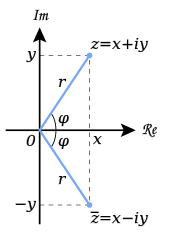
An illustration of the complex plane. The real part of a complex number z = x + iy is x, and its imaginary part is y.
Based on the concept of real numbers, a complex number is a number of the form a + bi, where a and b are real numbers and i is an indeterminate satisfying i2 = −1. For example, 2 + 3i is a complex number.[4]
This way, a complex number is defined as a polynomial with real coefficients in the single indeterminate i, for which the relation i2 + 1 = 0 is imposed. Based on this definition, complex numbers can be added and multiplied, using the addition and multiplication for polynomials. The relation i2 + 1 = 0 induces the equalities i4k = 1, i4k+1 = i, i4k+2 = −1, and i4k+3 = −i,which hold for all integers k; these allow the reduction of any polynomial that results from the addition and multiplication of complex numbers to a linear polynomial in i, again of the form a + bi with real coefficients a, b.
The real number a is called the real part of the complex number a + bi; the real number b is called its imaginary part. To emphasize, the imaginary part does not include a factor i; that is, the imaginary part is b, not bi.[5][6]
Formally, the complex numbers are defined as the quotient ring of the polynomial ring in the indeterminate i, by the ideal generated by the polynomial i2 + 1 (see below).[7]
NOTATION:
A real number a can be regarded as a complex number a + 0i whose imaginary part is 0. A purely imaginary number bi is a complex number 0 + bi whose real part is zero. As with polynomials, it is common to write a for a + 0i and bi for 0 + bi. Moreover, when the imaginary part is negative, that is, b = −|b| < 0, it is common to write a − |b|iinstead of a + (−|b|)i; for example, for b = −4,3 − 4i can be written instead of 3 + (−4)i.
Since in polynomials with real coefficients the multiplication of the indeterminate i and a real is commutative, the polynomial a + bi may be written as a + ib. This is often expedient for imaginary parts denoted by expressions, for example, when b is a radical.[8]
The real part of a complex number z is denoted by Re(z) or ℜ(z); the imaginary part of a complex number z is denoted by Im(z) or ℑ(z). For example,
and
In some disciplines, in particular electromagnetism and electrical engineering, jis used instead of i since i is frequently used to represent electric current.[9] In these cases complex numbers are written as a + bj or a + jb.
A complex number z can thus be identified with an ordered pair (Re(z), Im(z)) of real numbers, which in turn may be interpreted as coordinates of a point in a two-dimensional space. The most immediate space is the Euclidean plane with suitable coordinates, which is then called complex plane or Argand diagram,[10][11] named after Jean-Robert Argand. Another prominent space on which the coordinates may be projected is the two-dimensional surface of a sphere, which is then called Riemann sphere.
Cartesian complex plane:
The definition of the complex numbers involving two arbitrary real values immediately suggest the use of Cartesian coordinates in the complex plane. The horizontal (real) axis is generally used to display the real part with increasing values to the right and the imaginary part marks the vertical (imaginary) axis, increasing values upwards.
A charted number may be either viewed as the coordinatized point, or as a position vector from the origin to this point. The coordinate values of a complex number z are said to give its Cartesian, rectangular, or algebraic form.
Notably, the operations of addition and multiplication take on a very natural geometric character when complex numbers are viewed as position vectors: addition corresponds to vector addition, while multiplication (see below) corresponds to multiplying their magnitudes and adding the angles they make with the real axis. Viewed in this way the multiplication of a complex number by i corresponds to rotating the position vector counterclockwise by a quarter turn (90°) about the origin
Polar complex plane
Modulus and argument:
An alternative option for coordinates in the complex plane is the polar coordinate systemthat uses the distance of the point z from the origin (O), and the angle subtended between the positive real axis and the line segment Ozin a counterclockwise sense. This leads to the polar form of complex numbers.
The absolute value (or modulus or magnitude) of a complex number z = x + yi is[12]
If z is a real number (that is, if y = 0), then r = |x|. That is, the absolute value of a real number equals its absolute value as a complex number.
By Pythagoras' theorem, the absolute value of complex number is the distance to the origin of the point representing the complex number in the complex plane.The argument of z (in many applications referred to as the "phase" φ) is the angle of the radius Oz with the positive real axis, and is written as. As with the modulus, the argument can be found from the rectangular form
[13] by applying the inverse tangent to the quotient of imaginary-by-real parts. By using a half-angle identity a single branch of the arctan suffices to cover the range of the arg-function, (−π, π], and avoids a more subtle case-by-case analysis
Normally, as given above, the principal valuein the interval (−π, π] is chosen. Values in the range [0, 2π) are obtained by adding 2π if the value is negative. The value of φ is expressed in radians in this article. It can increase by any integer multiple of 2π and still give the same angle, viewed as subtended by the rays of the positive real axis and from the origin through z. Hence, the arg function is sometimes considered as multivalued. The polar angle for the complex number 0 is indeterminate, but arbitrary choice of the polar angle 0 is common.The value of φ equals the result of atan2:Together, r and φ give another way of representing complex numbers, the polar form, as the combination of modulus and argument fully specify the position of a point on the plane. Recovering the original rectangular co-ordinates from the polar form is done by the formula called trigonometric formUsing Euler's formula this can be written asUsing the cis function, this is sometimes abbreviated toIn angle notation, often used in electronics to represent a phasor with amplitude r and phase φ, it is written as[14]
Equality
Two complex numbers are equal if and only ifboth their real and imaginary parts are equal. That is, complex numbersand
are equal if and only if
and
. Nonzero complex numbers written in polar form are equal if and only if they have the same magnitude and their arguments differ by an integer multiple of 2π.
Ordering
Since complex numbers are naturally thought of as existing on a two-dimensional plane, there is no natural linear ordering on the set of complex numbers. In fact, there is no linear ordering on the complex numbers that is compatible with addition and multiplication – the complex numbers cannot have the structure of an ordered field. This is because any square in an ordered field is at least 0, but i2 = −1.Conjugate
The complex conjugate of the complex number z = x + yi is given by x − yi. It is denoted by eitheror z*.[24] This unary operation on complex numbers cannot be expressed by applying only their basic operations addition, subtraction, multiplication and division.
Geometrically,is the "reflection" of z about the real axis. Conjugating twice gives the original complex number
which makes this operation an involution. The reflection leaves both the real part and the magnitude ofunchanged, that is
and
The imaginary part and the argument of a complex numberchange their sign under conjugation
and
For details on argument and magnitude, see the section on Polar form.The product of a complex numberand its conjugate is always a positive real number and equals the square of the magnitude of each:
This property can be used to convert a fraction with a complex denominator to an equivalent fraction with a real denominator by expanding both numerator and denominator of the fraction by the conjugate of the given denominator. This process is sometimes called "rationalization" of the denominator (although the denominator in the final expression might be an irrational real number), because it resembles the method to remove roots from simple expressions in a denominator.The real and imaginary parts of a complex number z can be extracted using the conjugation:and
Moreover, a complex number is real if and only if it equals its own conjugate.Conjugation distributes over the basic complex arithmetic operations:Conjugation is also employed in inversive geometry, a branch of geometry studying reflections more general than ones about a line. In the network analysis of electrical circuits, the complex conjugate is used in finding the equivalent impedance when the maximum power transfer theorem is looked for.Addition and subtraction
Two complex numbersand
are most easily added by separately adding their real and imaginary parts of the summands. That is to say:
Similarly, subtraction can be performed as
Using the visualization of complex numbers in the complex plane, the addition has the following geometric interpretation: the sum of two complex numbersand
, interpreted as points in the complex plane, is the point obtained by building a parallelogram from the three vertices
, and the points of the arrows labeled
and
(provided that they are not on a line). Equivalently, calling these points
respectively and the fourth point of the parallelogram
the triangles
and
are congruent. A visualization of the subtraction can be achieved by considering addition of the negative subtrahend.
Multiplication
Since the real part, the imaginary part, and the indeterminatein a complex number are all considered as numbers in themselves, two complex numbers, given as
and
are multiplied under the rules of the distributive property, the commutative properties and the defining property
in the following way
Reciprocal and division
Using the conjugation, the reciprocal of a nonzero complex number z = x + yi can always be broken down tosince non-zero implies thatis greater than zero.
This can be used to express a division of an arbitrary complex numberby a non-zero complex number
as
Multiplication and division in polar form
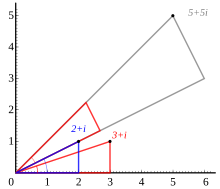
Multiplication of 2 + i (blue triangle) and 3 + i (red triangle). The red triangle is rotated to match the vertex of the blue one and stretched by √5, the length of the hypotenuse of the blue triangle.Formulas for multiplication, division and exponentiation are simpler in polar form than the corresponding formulas in Cartesian coordinates. Given two complex numbers z1 = r1(cos φ1 + i sin φ1) and z2 = r2(cos φ2 + i sin φ2), because of the trigonometric identities- We may write,
In other words, the absolute values are multiplied and the arguments are added to yield the polar form of the product. For example, multiplying by i corresponds to a quarter-turn counter-clockwise, which gives back i2 = −1. The picture at the right illustrates the multiplication ofSince the real and imaginary part of 5 + 5i are equal, the argument of that number is 45 degrees, or π/4 (in radian). On the other hand, it is also the sum of the angles at the origin of the red and blue triangles are arctan(1/3) and arctan(1/2), respectively. Thus, the formulaholds. As the arctan function can be approximated highly efficiently, formulas like this – known as Machin-like formulas – are used for high-precision approximations of π.Similarly, division is given by
-
-
-
Square root
-
-
-
-
-
- The square roots of a + bi (with b ≠ 0) are
, where
and
-
-
-
Functional equation
-
The exponential function satisfies the functional equationThis can be proved either by comparing the power series expansion of both members or by applying analytic continuation from the restriction of the equation to real arguments.
-
Euler's formula
-
Euler's formula states that, for any real number x,
The functional equation implies thus that, if xand y are real, one haswhich is the decomposition of the exponential function into its real and imaginary parts.
-
Complex logarithm
-
- In the real case, the natural logarithm can be defined as the inverse of the exponential function. For extending this to the complex domain, one can start from Euler's formula. It implies that, if a complex number z is written in polar formthen its complex logarithm should beHowever, because cosine and sine are periodic functions, the addition to
of an integer multiple of 2π. does not change z. For example,
, so both
and
are possible values for the natural logarithm of
.
Therefore the complex logarithm must be defined as a multivalued function:Alternatively, a branch cut can be used to define a true function. If z is not a negative real number, the principal value of the complex logarithm is obtained withThis is an analytic functionoutside the negative real numbers, but it cannot be prolongated to a function that is continuous at any negative real number.
It follows that if z is as above, and if t is another complex number, then the exponentiation is the multivalued function
First learn about NUMBERS:
Types of NUMBERS;
- Natural numbers
- Whole numbers
- Integers
- Rational numbers
- Irrational numbers
- Real numbers
- Algebraic numbers
- Complex numbers
- Imaginary numbers
The numbers used for counting. That is, the numbers 1, 2, 3, 4, etc.
Natural Numbers
Counting Numbers
Natural Numbers
Counting Numbers

Whole Numbers
Nonnegative Integers
Nonnegative Integers
The numbers 0, 1, 2, 3, 4, 5, etc.

Integers
All positive and negative whole numbers (including zero). That is, the set {... , –3, –2, –1, 0, 1, 2, 3, ...}. Integers are indicated by either  or J.
or J.

Rational Numbers
All positive and negative fractions, including integers and so-called improper fractions. Formally, rational numbers are the set of all real numbers that can be written as a ratio of integers with nonzero denominator. Rational numbers are indicated by the symbol  .
.
Note: Real numbers that aren't rational are called irrational.

Real Numbers
All numbers on the number line. This includes (but is not limited to) positives and negatives, integers and rational numbers, square roots, cube roots , π (pi), etc. Real numbers are indicated by either

Algebraic Numbers
Real numbers that can occur as roots of polynomial equationsthat have integer coefficients. For example, all rational numbersare algebraic. So are all surds such as , as well as numbers built from surds such as the number below.
.
Note: Real numbers which are not algebraic are known as transcendental numbers.

Algebraic Numbers
Real numbers that can occur as roots of polynomial equationsthat have integer coefficients. For example, all rational numbersare algebraic. So are all surds such as , as well as numbers built from surds such as the number below.
.
Note: Real numbers which are not algebraic are known as transcendental numbers.

Algebraic Numbers
Real numbers that can occur as roots of polynomial equationsthat have integer coefficients. For example, all rational numbersare algebraic. So are all surds such as , as well as numbers built from surds such as the number below.
.
Note: Real numbers which are not algebraic are known as transcendental numbers.

|
Complex Number Formulas



 ImaginaryNumbers
ImaginaryNumbers
Pure Imaginary Numbers
Complex numbers with no real part, such as 5i.

Real Numbers
All numbers on the number line. This includes (but is not limited to) positives and negatives, integers and rational numbers, square roots, cube roots , π (pi), etc. Real numbers are indicated by either  or
or  .
.

Complex Conjugate
The complex conjugate of a + bi is a – bi, and similarly the complex conjugate of a – bi is a + bi. This consists of changing the sign of the imaginary part of a complex number. The real part is left unchanged.
Complex conjugates are indicated using a horizontal line over the number or variable. For example,  .
.
Note: Complex conjugates are similar to, but not the same as, conjugates.
| Expression | Complex Conjugate | ||||||||||
|
|
De Moivre’s Theorem

Polar Form of a Complex Number
The polar coordinates of a complex number on the complex plane. The polar form of a complex number is written in any of the following forms: rcos θ + irsin θ, r(cos θ + isin θ), or rcis θ. In any of these forms r is called the modulus or absolute value. θ is called the argument.







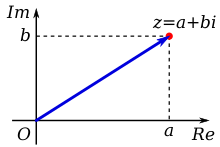
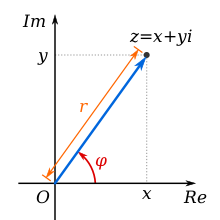

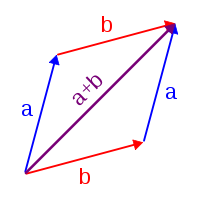
 that can be written as the
that can be written as the 
Post a Comment